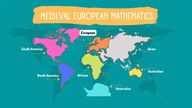
Return to flip book view
North AmericaAfrican EuropeanSouth America Asian Australian Antarctica MEDIEVAL EUROPEAN MATHEMATICS
OUTLINEBRIEF HISTORYSHORT QUIZMATHEMATICIANS& CONTRIBUTIONSEUROPENOTE: THERE WILL BE A SHORT QUIZ IN THE LAST PART.
During the centuries in which the Chinese, Indian and Islamicmathematicians had been in the ascendancy, Europe had fallen into theDark Ages, in which science, mathematics and almost all intellectualendeavour stagnated.Scholastic scholars only valued studies in the humanities, such asphilosophy and literature.A BRIEF HISTORY
From the 4th to 12th Centuries, European knowledge and study ofarithmetic, geometry, astronomy and music was limited mainly toBoethius’ translations to Latin of some of the works of ancient Greekmasters such as Nicomachus and Euclid. Since the organization of theQuadrivium was formalized by Boethius, and this structure endured forover a millennium. It was the mainstay of the medieval monastic systemof education, which had a structure of seven subjects – the seven liberalarts – comprising the Trivium and the Quadrivium.A BRIEF HISTORY
QUADRIVIUMQuadrivium means four ways andwere translated by Boethius to Latin.The first is arithmetic, concerned withthe infinite linear array of numbers.Moving beyond the line to higher-dimensional spaces, we havegeometry. The third discipline is musicor harmony, which is, fundamentally,an application of the pure science ofnumbers evolving in time. Fourthcomes astronomy, the application ofgeometry to the world of space.
The prevalent numerical system inmedieval Europe was the Romannumeral system, inherited from theancient Romans.The abacus, an ancient calculatingdevice, continued to be used duringthe medieval period. Simple arithmetic calculations wereoften performed using fingers ascounting aids.
By the 12th Century, though, Europe, and particularly Italy, was beginningto trade with the East, and Eastern knowledge gradually began to spreadto the West. Robert of Chester translated Al-Khwarizmi‘s important bookon algebra into Latin in the 12th Century, and the complete text of Euclid‘s“Elements” was translated in various versions by Adelard of Bath, Hermanof Carinthia and Gerard of Cremona. In which, the use of Hindu-Arabicnumeral system was spread through Fibonacci throughout Europe earlyin the 13th Century. That soon made the Roman numeral systemobsolete, and opened the way for great advances in Europeanmathematics.A BRIEF HISTORY
Hinnu-Arabic numerals coexisted with the use of the abacus until theearly 13th century.
The advent of the printing press in the mid-15thCentury also had a huge impact. Numerous books onarithmetic were published for the purpose ofteaching business people computational methods fortheir commercial needs and mathematics graduallybegan to acquire a more important position ineducation.A BRIEF HISTORY
A BRIEF HISTORYDark Age (Intellectual decline)Translation from Greek to LatinTrivium & Quadrivium (Boethius)Roman numerals & AbacusHindu-arabic numerals(Fibonacci)Numerous Books